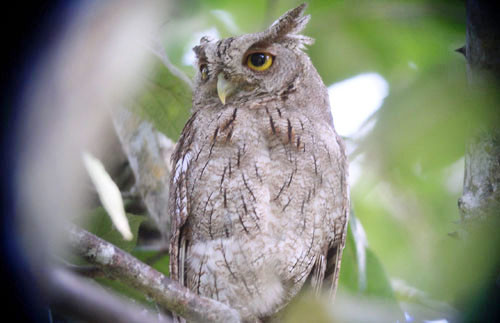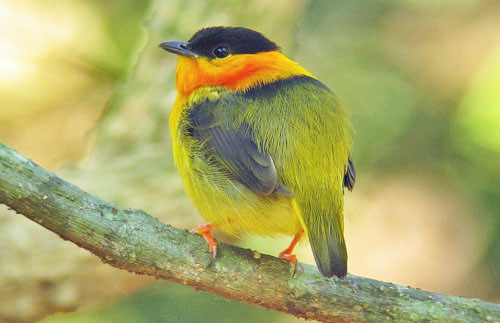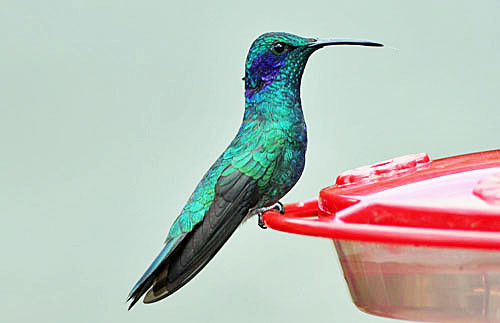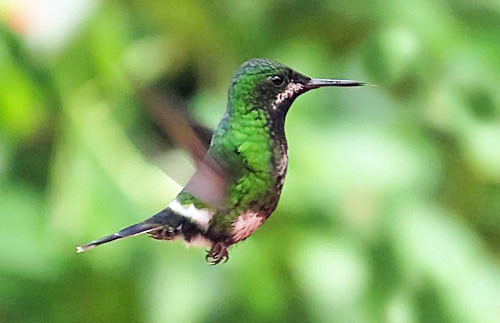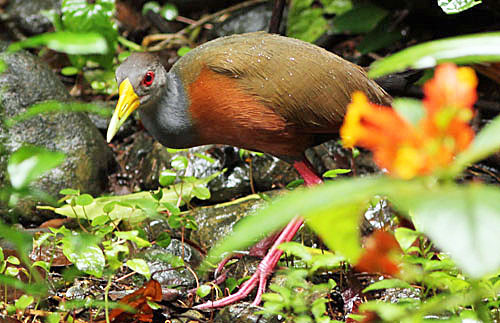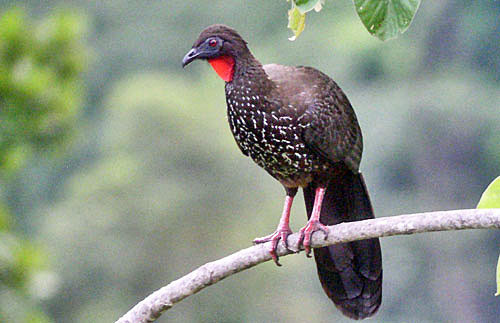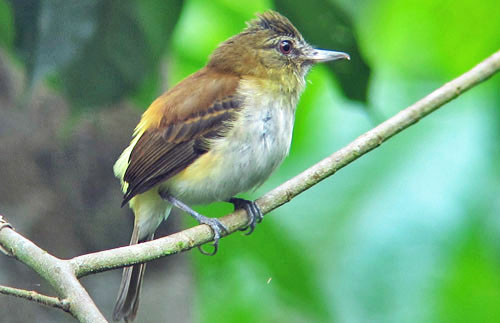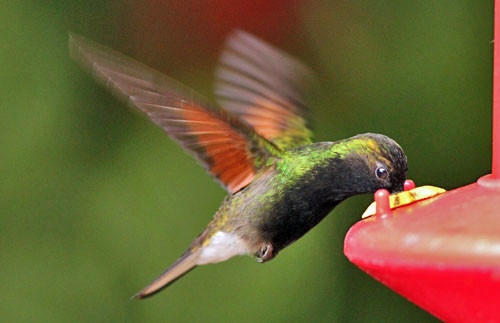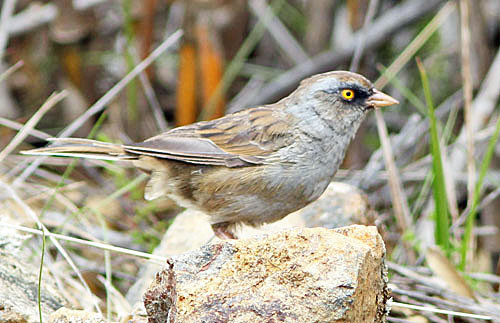 One of the most range-restricted birds in the Talamanca Highlands is the Volcano Junco.
Photo: Rich Hoyer
One of the most range-restricted birds in the Talamanca Highlands is the Volcano Junco.
Photo: Rich Hoyer With an area of less than 20,000 square miles, Costa Rica is the third-smallest nation in Central America. But in proportion to the country’s size, its avifauna, comprising nearly 900 species, is among the richest in the world. For the visiting birder, this modern and politically stable country presents the obvious advantage of compactness combined with excellent hotels and lodges, delicious food, stunning scenery, friendly people, and fantastic birding. Our tour concentrates on the best birding areas, from the oak forests of the Talamanca Highlands with its many endemics and Resplendent Quetzals, to the rich Osa Peninsula in the Pacific lowlands, the stunning cloud forest at Monteverde, and the Caribbean lowlands, where we’ll stay at a resort with very birdy grounds near La Selva Biological Station and Braulio Carrillo National Park. We should see more than 400 species over our 13 days of birding.
Day 1: The tour begins at 6 pm this evening in the lobby of our hotel. Night in Heredia.
Great tour. Rich Hoyer is a savant with birds (and other wildlife) and is worth the money just to watch.
William Higgins, Mar. 2019
Day 2: The Central Valley, where we begin our tour, is bounded to the east by the Cordillera de Talamanca, a vast mountain range protected in national parks or biological preserves. One national park, Tapantí-Macizo Cerro de la Muerte, is only a short distance from San José, and we’ll spend the whole morning exploring its lush cloud forest. Here we’ll have our first chance at many montane forest species such as Black Guan, White-bellied Mountain-gem, Collared Trogon, Prong-billed and Red-headed Barbets, Golden-bellied Flycatcher, Torrent Tyrannulet, and Spangle-cheeked and Bay-headed Tanagers. Several species otherwise rare in Central America are seen regularly at Tapantí, including Green-fronted Lancebill, Silvery-fronted Tapaculo, and Wrenthrush. In the afternoon we’ll continue to our hotel, where the garden drips with blooming fuchsias and begonias in a high mountain valley below Cerro de la Muerte. Night in San Gerardo de Dota.
Day 3: Our hotel is in a lovely valley in the Cordillera de Talamanca, where we’ll have easy access to most of the montane species endemic to the area, also known as the Chiriqui Highlands, which extends into westernmost Panama. We’ll birdwatch along dirt roads through mid-elevation montane forest, where we’ll encounter many new species including Fiery-throated Hummingbird, Black-capped Flycatcher, Long-tailed Silky-flycatcher, Sooty and Mountain Thrushes, Sooty-capped Chlorospingus, and Yellow-thighed and Large-footed Finches. The gardens of our hotel may give us our first views of the magnificent Resplendent Quetzal, for which there’s sure to be a fruiting aguacatillo tree or an active nest within a short walk or drive. At flowers and hummingbird feeders we can expect many species of hummingbirds, including White-throated Mountain-gem, Lesser Violetear, Talamanca, and Volcano Hummingbirds. During our stay here we’ll continue up the cordillera, where above treeline we’ll look for such high-elevation specialties as Timberline Wren, Peg-billed Finch, and Volcano Junco. Night in San Gerardo de Dota.
Day 4: After a final look for any specialties we may have missed – perhaps Black-cheeked Warbler, Buffy Tuftedcheek, or Ochraceous Pewee – we’ll drop out of the highlands and work our way south. We’ll make opportunistic roadside stops as we start noticing more and more tropical birds from the bus, such as Roadside Hawk, Gray-capped Flycatcher, or perhaps even Pearl Kite or Streaked Saltator. As we continue down to the Pacific lowlands near Golfito and on to the more humid Osa Peninsula, roadside birds could include such tropical excitement as Yellow-throated Toucan, Crested Guan, and Golden-naped Woodpecker. We’ll plan to arrive at our lodge with enough time to get oriented and perhaps do some owling near the grounds. Night at Bosque del Río Tigre.
Days 5–6: The Osa Peninsula is in the heart of the South Central American Pacific Slope endemic bird area. Not only does it host all of the region’s endemics, such as the blue and red Baird’s Trogon, the well-named Fiery-billed Aracari, the lovely Turquoise Cotinga, Black-hooded Antshrike, and Spot-crowned Euphonia, it’s also home to the very localized Costa Rican endemic Black-cheeked Ant-Tanager. Most of the birding is right at our lodge, where we stand a good chance of seeing all of those specialties. The feeders usually have visiting Little Tinamou, one of the best places to see this very secretive bird, and Black-faced Antthrushes walk around near the compost pile at dawn and dusk. Mixed flocks on the forest trails often have Long-billed Gnatwren, White-shouldered Tanager, Plain Xenops, and several woodcreepers, and a couple of ponds usually have Boat-billed Heron and a chance for American Pygmy Kingfisher. We’ll also have optional afternoon excursion which involves wading up the shallow El Tigre River and a nearby stream in search of rarely-seen specialties such as White-crested Coquette and White-tipped Sicklebill. The birding in this area is extremely rich, and day lists of over 120 species while birding on foot and never more than a kilometer from our lodge is quite likely. Nights at Bosque del Río Tigre.
Day 7: The first stop on our way north today will most likely be the Rincón bridge where the old-growth rainforest and mangroves are home to the rare and declining Yellow-billed Cotinga. This snow-white, silent member of the cotinga family is often seen flying back and forth from fruiting trees in the forest to the mangroves where they breed. We’ll also have a chance for the endemic Mangrove Hummingbird, which requires the piñuela tree, found only in this country’s Pacific coast mangrove forests. The roadside birding as we pass north through a mosaic of forest and agricultural land could produce Southern Lapwing (a recent immigrant), Brown Capuchin, or even a Three-toed Sloth in roadside cecropia trees. Stopping at bridges has resulted in eye-popping views of Red-legged Honeycreeper below eye level—deep purple with a shiny sky-blue crown—several species of kingfisher, and Mangrove Swallow, while wet ditches and roadside ponds have been good bets for Bare-throated Tiger-Heron, Northern Jacana, and groups of Wood Storks and Roseate Spoonbills. We’ll arrive at our next hotel in the late afternoon, leaving us time to enjoy the grounds, where Rose-throated Becard and Rufous-naped Wren are likely. Night near Carara.
Day 8: We’ll have a couple early morning hours on a boat ride on the Tárcoles River and through the mangrove forest, where Collared Plover, Black-necked Stilt, Mangrove Vireo, and Yellow-naped Parrot are some of the target birds, while the abundance of life and diversity of water birds will make this short excursion a highlight of the tour. In the late morning until lunchtime we’ll pass through pastureland and patches of tropical deciduous forest where we could see such new species as Cinnamon Hummingbird, Plain-capped Starthroat, Turquoise-browed Motmot, Banded Wren, White-lored Gnatcatcher, Olive Sparrow, Double-striped Thick-knee, and possibly the elusive Lesser Ground-Cuckoo, with lunch at a lodge on the Gulf of Nicoya coast. We’ll spend the afternoon driving to a more comfortable elevation in the Cordillera de Tilarán. Night in Monteverde.
Day 9: We’ll spend all day visiting cloud forest reserves in the Monteverde area. We’ll be right on the Continental Divide in one of the best-known birding localities in Central America. In spring the preserves are famous for nesting Resplendent Quetzals and calling Three-wattled Bellbirds—audible a mile away. We’ll search for these, of course, and for many other species including Orange-bellied Trogon, Prong-billed Barbet, Lineated Foliage-gleaner, Streak-breasted Treehunter, Tawny-throated and Gray-throated Leaftossers, Azure-hooded Jay, Slaty-backed Nightingale-Thrush, Costa Rican Warbler, Golden-browed Chlorophonia, and Chestnut-capped Brushfinch. If we’re lucky we may encounter one of the area’s difficult-to-see specialties, such as Black-breasted Wood-Quail or Buff-fronted Quail-Dove. We’ll also visit the Hummingbird Gallery at the entrance to the cloud forest reserve, where we’re likely to see up to eight species of hummingbird including numerous Violet Sabrewings and Coppery-headed Emerald. Our hotel grounds are great for birding too, where Lesson’s Motmot, Rufous-and-white Wren, and Mottled Owl are regularly seen. Night in Monteverde.
Day 10: We’ll begin our final morning at Monteverde with a visit to the decidedly drier forest of the private Santuario Ecológico. The birds in this type of forest are quite different from those found only a couple miles away in the wetter preserves, and we’ll have a chance of seeing Long-tailed Manakin, Golden-crowned Warbler, White-eared Ground-Sparrow, and possibly Chiriqui Quail-Dove and Orange-billed Nightingale-Thrush. Before lunch we’ll depart for the Caribbean lowlands, passing around the reservoir of Lake Arenal, and approaching the volcano of the same name. In the forest near the volcano we’ve seen lowland species such as Slaty-tailed Trogon, White-fronted Nunbird, Keel-billed Motmot, and the adorable Black-headed Tody-Flycatcher. We’ll have the later afternoon to explore these foothill habitats around the volcano on the way to our lodge. If it’s clear, the view of the volcano from our rooms is breathtaking. Night near Arenal Volcano.
Days 11–13: We’ll spend the morning of day 11 birding trails in the Arenal region. The trail here takes us through an excellent patch of foothill forest, where we hope to find Dull-mantled and Spotted Antbirds, Carmiol’s and White-throated Shrike-Tanagers, Streak-crowned Antvireo, and perhaps the rare Lattice-tailed Trogon. Great Curassow is now more common and confiding than in the past, making it almost a certain thing. After lunch near Arenal Volcano, we’ll continue to the Sarapiquí region for two full days.
On one day we’ll visit La Selva, a biological station operated by the Organization for Tropical Studies. This roughly 1,400-acre reserve is adjacent to Braulio Carrillo National Park and is managed as a natural research laboratory. About 475 species of birds have been recorded at La Selva, and although we won’t see that many in a one-day visit, we’ll certainly experience the avian richness of the region. La Selva is an excellent place to see Great and Slaty-breasted Tinamous, Rufous and Broad-billed Motmots, Keel-billed Toucans, Pied and White-necked Puffbirds, Great and Fasciated Antshrikes, Black-throated and Gartered Trogons, Snowy Cotinga, White-ringed Flycatcher, Stripe-breasted Wren, Plain-colored Tanager, Black-headed Saltator, and Chestnut-colored, Cinnamon, and Rufous-winged Woodpeckers, among many, many others. Our visit to La Selva will be an especially memorable part of the trip.
On another day we’ll visit Braulio Carrillo National Park. This park, which protects one of the last untouched expanses of Caribbean foothill forest in Central America, is only a 25-minute drive from our hotel. We’ll have all day to search the forest trails for such specialties as Lattice-tailed Trogon, Yellow-eared Toucanet, White-ruffed Manakin, Black-headed Nightingale-Thrush, and Blue-and-gold, Black-and-yellow, Emerald, Carmiol’s, White-throated Shrike-, and Tawny-crested Tanagers. With luck we may see one of the truly rare species found in the park, such as Black-crowned Antpitta or Lanceolated Monklet. We’ll likely have time to stop at a patch of roadside flowers where in past years we have found Snowcap and Black-crested Coquette. Nights in the Sarapiquí region.
Day 14: There will be time for a leisurely exploration of the often very birdy grounds of our lodge. Snowy Cotinga might be feeding in the fruiting cecropia trees near the entrance, while a check of the gravel bars on the river might reveal a Sunbittern or a Fasciated Tiger-Heron. We’ll depart in time to have lunch at the famous La Paz Waterfall Gardens, where a few more hummingbirds might welcome us. We’ll arrive at our hotel in Heredia in time to pack and enjoy a farewell dinner. Night in Heredia.
Day 15: The tour concludes this morning in San José.
Updated: 23 February 2024
Prices
- 2025 Tour Price Not Yet Known
- (2024 Tour Price $6,550)
Notes

Questions? Tour Manager: Greg Greene. Call 1-866-547-9868 (US or Canada) or (01) 520-320-9868 or click here to email.
* Tour invoices paid by check carry a 4% discount. Details here.
This tour is limited to eight participants with one leader.
*The 2025 tour will be run in the reverse direction/order.

